Table of Contents Show
Introduction
Welcome to the world of Japandi Gardens, a delightful fusion of Japanese and Scandinavian design principles.
Think of a peaceful outdoor retreat, where tranquillity reigns supreme, and the hustle-bustle of city life seems miles away. That’s what we aim to achieve with Japandi aesthetics. This article serves as your guide to designing your very own Zen-inspired outdoor space, regardless of its size.
An inviting yard or even a small balcony can be transformed into a serene haven embracing Japandi style. The key lies in understanding the importance of creating tranquil outdoor spaces and identifying the elements that contribute to a Zen-like ambiance in Japandi gardens.
A brief overview of these elements includes:
- Minimalist Design: Less is more in a Japandi garden. Inspired by Japanese minimalism and Scandinavian comfort, clutter-free spaces with clean lines are preferred.
- Natural Materials: To create a harmonious blend between aesthetics and sustainability, natural materials are favored.
- Plants Selection: The choice of plants is crucial in maintaining simplicity and balance while contributing to the overall serenity.
As you embark on this journey, don’t hesitate to explore tips for fall cleaning to ensure proper maintenance of your yard and garden tools. Additionally, if you’re in the process of preparing to design your landscape, we have some useful insights that will help you make informed decisions.
Even if you have foundation gardens, our guide on effective landscapes can provide valuable information on critical plantings that contribute to an aesthetically pleasing outdoor space.
1. Embracing Japandi Style in Outdoor Spaces
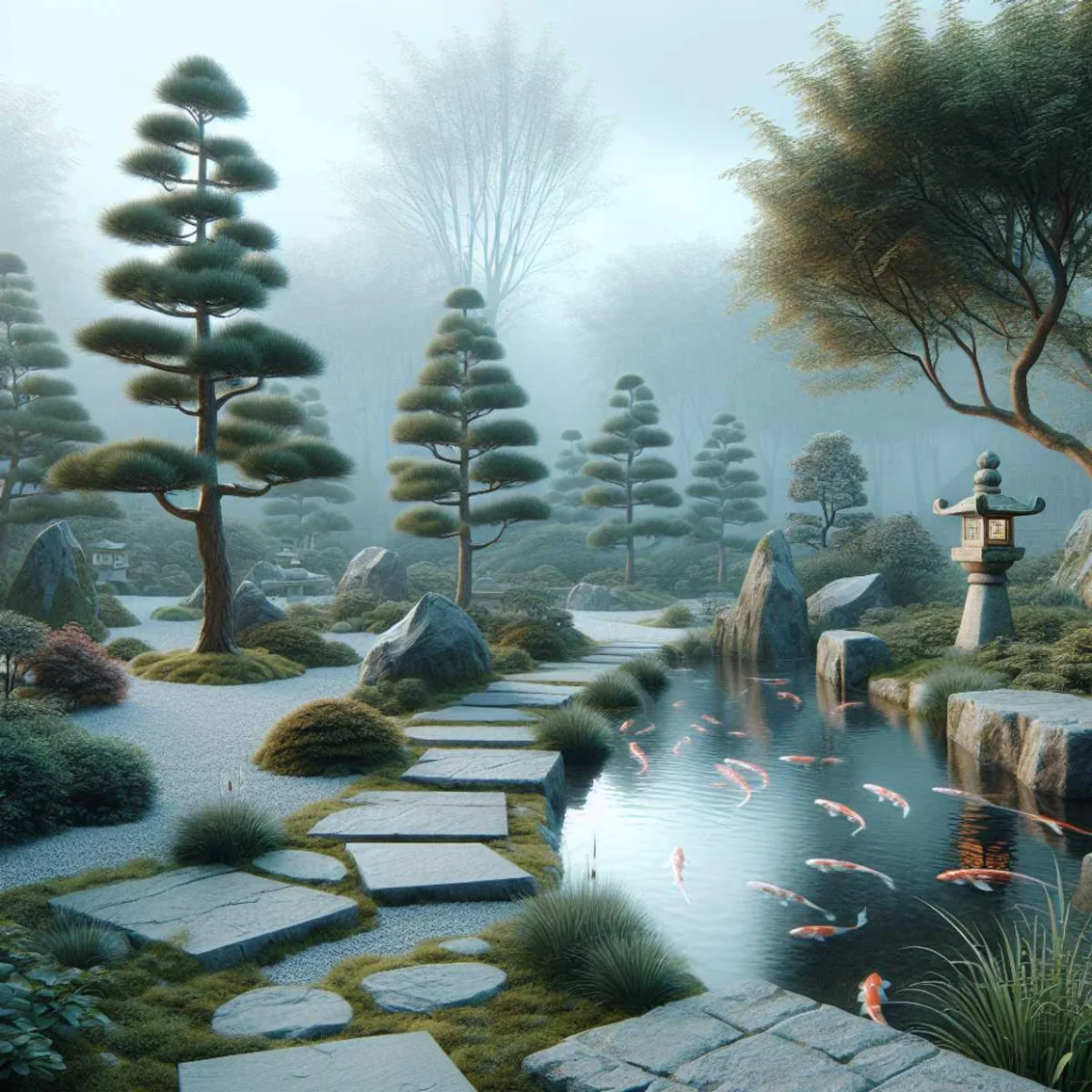
Japandi gardens are a perfect combination of tranquility and minimalism, where every element is purposeful and contributes to a peaceful outdoor area. In this section, we will explore the key features that define Japandi style in your garden or balcony.
Simplicity and Functionality
At the core of Japandi style is the merging of Japanese minimalism with Scandinavian practicality. This design approach focuses on:
- Clean lines: Creating a Japandi garden involves keeping things simple. The use of clean and uncluttered lines helps create a sense of calmness and order.
- Thoughtfully designed open spaces: Empty areas in a Japandi garden are not just left blank; they are intentionally designed to provide visual and mental relaxation.
- Functional beauty: Every item in a Japandi garden serves a purpose and has its own aesthetic value, ensuring that nothing is unnecessary or excessive.
Natural Materials
The choice of materials in Japandi gardens goes beyond aesthetics – it also emphasizes their naturalness and sustainability. Here are some examples of natural materials commonly used in Japandi outdoor spaces:
- Stone features: Incorporating stones into pathways, creating rock gardens, or using them as benches add a timeless and solid element to the overall design.
- Gravel and sand: These elements can be used to mimic the appearance of flowing water or add texture to the ground, allowing you to feel more connected to nature as you walk around.
- Wood elements: Whether it’s using bamboo for fences or opting for teak furniture, integrating wood brings warmth and an organic touch to the space.
Harmony with Nature
In Japandi design, it is essential to establish a strong connection with the natural environment. This involves choosing materials that not only look natural but are also sourced sustainably or reclaimed. The same principle applies when selecting plants for your garden.
Integration with Seasons
A crucial aspect of Japandi gardening is considering how your outdoor space will change throughout the year. Understanding the seasonal transitions allows you to make informed decisions when it comes to plant selection and arrangement. Each choice should align with Japandi principles – refined yet relaxed, simple yet deeply connected to nature. For instance, during fall gardening, understanding what needs to be done to your plants as the weather becomes cooler and leaves start changing is vital.
Avoiding Common Pitfalls
When adopting Japandi style in your outdoor space, it’s important to be aware of common design mistakes that can undermine its essence. One such pitfall is creating a cluttered or overly busy garden, which can quickly take away from the intended Zen-like atmosphere. Remember, simplicity and symmetry are key elements to keep in mind when planning your Japandi garden. You might find this article on landscape planning mistakes helpful in avoiding some of these pitfalls.
Embracing the Cycle of Life
Japandi gardens embrace the cycle of life and death, acknowledging that both are integral parts of nature’s harmony. This philosophy extends to the way we approach our gardens as well. Instead of fearing or avoiding it, we can learn to cope with death in our outdoor spaces
2. Creating Serenity Through Landscaping
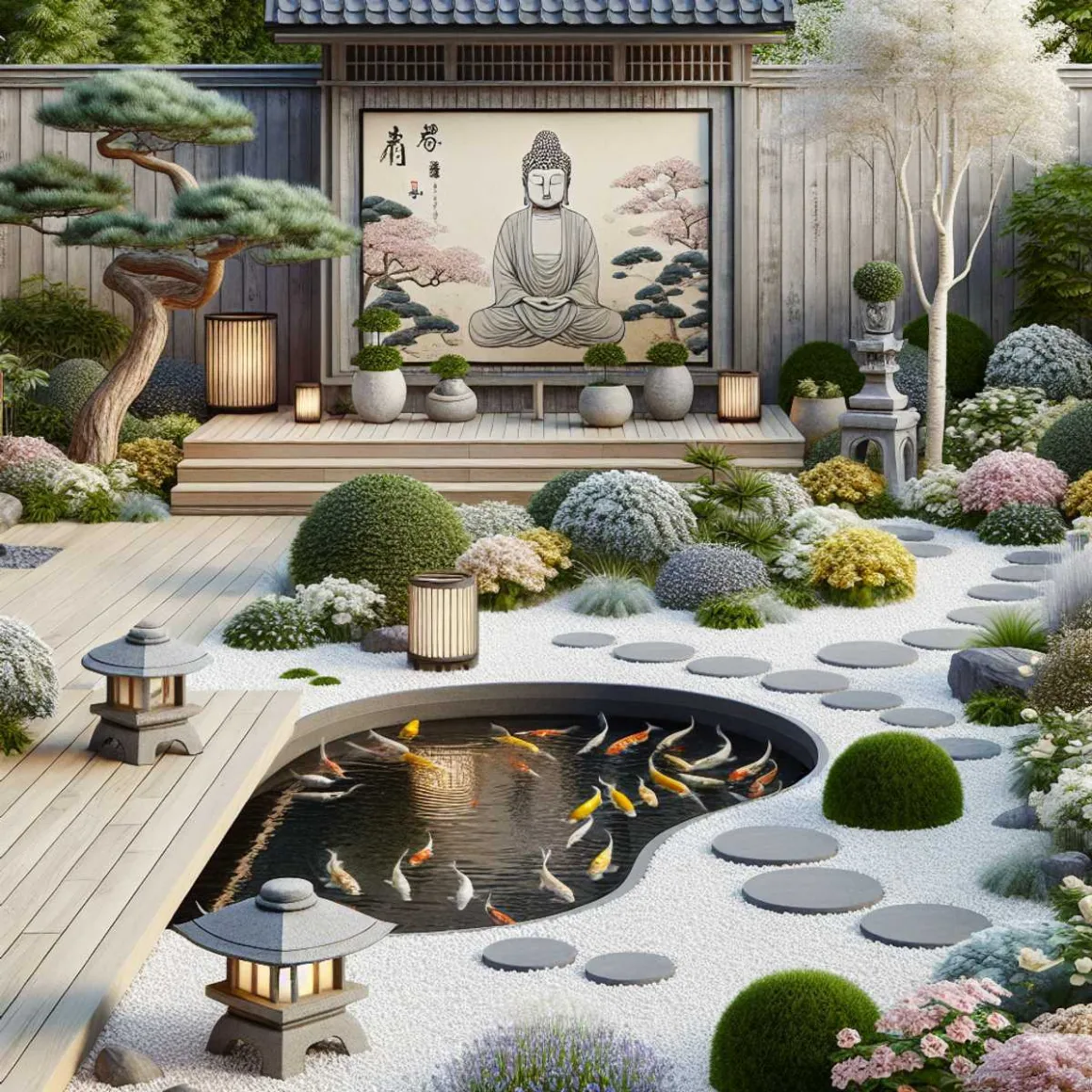
A garden’s soul lies in its landscaping—a well-crafted layout that guides the eye and the feet, promoting peace with every step. The Japandi garden is no exception, where serenity and tranquility are not just desired but essential. Let’s delve into how you can sculpt your outdoor space with natural materials to nurture a serene atmosphere.
Well-Planned Landscaping: The Blueprint of Peace
Crafting a Japandi garden requires intention. Every boulder, path, and plant is chosen for its ability to contribute to an overarching sense of calm. This meticulous approach ensures that the garden is not just a space, but a cohesive sanctuary for reflection and restoration.
The Harmony of Natural Materials
Stone, gravel, and wood are more than mere materials; they are the tactile expressions of nature’s diversity and beauty. Here’s how they can transform your garden:
- Stone: A symbol of strength and timelessness, stone can be used in various forms—from pebbles lining a meandering path to large rocks anchoring corners of the garden. Landscaping your yard in the Japanese garden style provides insights into incorporating stone elements effectively.
- Gravel: The gentle crunch underfoot on a gravel path acts as a call to the present moment, while also providing excellent drainage.
- Wood: Whether it’s sleek decking or rustic benches, wood brings warmth and organic lines into the minimalist Japandi aesthetic.
These elements should blend seamlessly into the surroundings, creating a dialogue between artificial structures and natural beauty.
Zen Elements: Inviting Stillness
Incorporate Zen features to elevate the tranquil vibe:
- Rock Gardens: A quintessential element in Japanese gardens, rock gardens encourage contemplation with their abstract representations of natural landscapes.
- Water Features: The sound of water is synonymous with tranquility. A simple bamboo fountain or a still pond can become focal points for meditation.
When considering new varieties that could complement your serene space, remember that breeding plants to be hardier and healthier means they’ll thrive with less fuss. Simplicity in care contributes to serenity in ambiance.
As you curate each aspect of your Japandi landscape, imagine how each element works together to create a canvas of calm—the kind that invites you to pause and breathe deeply. And for those moments when you wish to add a personal touch without disturbing the tranquility, consider using canvas prints in your outdoor area for an artistic yet harmonious accent.
While selecting decor and furnishings later on will further enhance your garden’s mood, remember there are always outdoor décor ideas to draw inspiration from. But for now, focus on laying down the foundations of landscaping—where every stone, plant, and water droplet is part of a larger tapestry woven with serenity at its heart.
3. Selecting Plants for a Japandi Garden
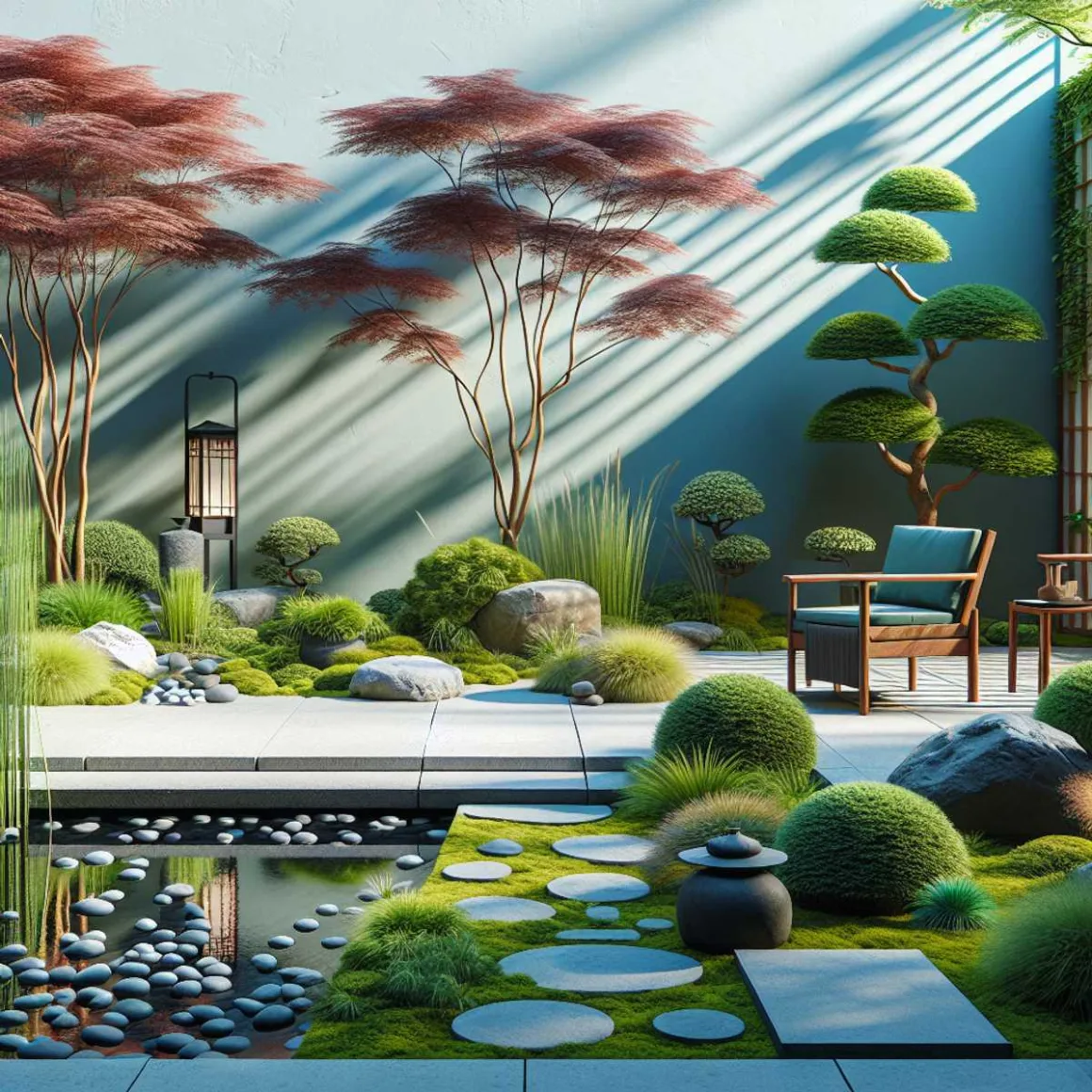
When you envision a Japandi garden, picture it as a blank canvas where each plant is thoughtfully chosen to create a serene and balanced landscape. Selecting the right plants goes beyond aesthetics; it’s about curating a scene that embodies the minimalist essence of Japandi design and evokes a sense of tranquility. Here are some principles and plant suggestions to help you cultivate that Zen atmosphere.
Choosing Plants in Line with Minimalist Design
The heart of Japandi style lies in its minimalist approach, which means opting for plants that are simple and not overly elaborate. Look for species that exude tranquility rather than disorder, and arrange them in a way that gives each plant enough space. Remember, simplicity is key—less is more.
Key Plant Options
Several plants are synonymous with the soothing atmosphere of a Japandi garden:
- Cherry Blossoms (Sakura): Delicate pink blossoms provide a fleeting but memorable display, encapsulating the Japanese concept of ‘mono no aware’—the poignant beauty of impermanence.
- Black Pines: These sturdy trees offer year-round greenery and are often shaped into elegant forms through careful pruning.
- Bonsai/Kokedama: Miniature trees and moss balls represent nature in miniature, bringing an artistic touch and focus on detailed care.
- Evergreens: With their enduring presence, they ground the garden’s design, providing continuity through the seasons.
Plant these living elements with intention, allowing each to serve as a focal point or to contribute quietly to the overall harmony.
Zen-Inspired Arrangements
Taking inspiration from traditional Zen gardens, incorporate arrangements that encourage contemplation. Rock gardens adorned with moss can create a serene backdrop for thoughtfully placed bonsai or kokedama. Arrange plants in odd numbers—a practice rooted in Japanese gardening—to create natural asymmetry and balance.
Maintaining simplicity in your plant choices doesn’t mean neglecting seasonal lawn care. As the colder months approach, it’s important to prepare and maintain your lawn for winter, with a focus on protection and preservation.
For those seeking ideas beyond traditional Japandi elements, consider how Mediterranean gardens use terracotta pots and warm outdoor lighting to elevate their spaces. You can apply a similar approach in a Japandi context by selecting appropriate materials that reflect both cultures.
Lastly, inclusivity is crucial in every garden. Make sure your Japandi garden is accessible to all by embracing practices that welcome everyone. Explore the benefits, methods, and tips for gardening in a wheelchair, which can also be applied to creating peaceful areas for those with mobility concerns.
By integrating these elements harmoniously, your garden becomes an extension of the home—a sanctuary where nature’s beauty is displayed in its purest form.
4. Enhancing the Ambiance with Outdoor Decor
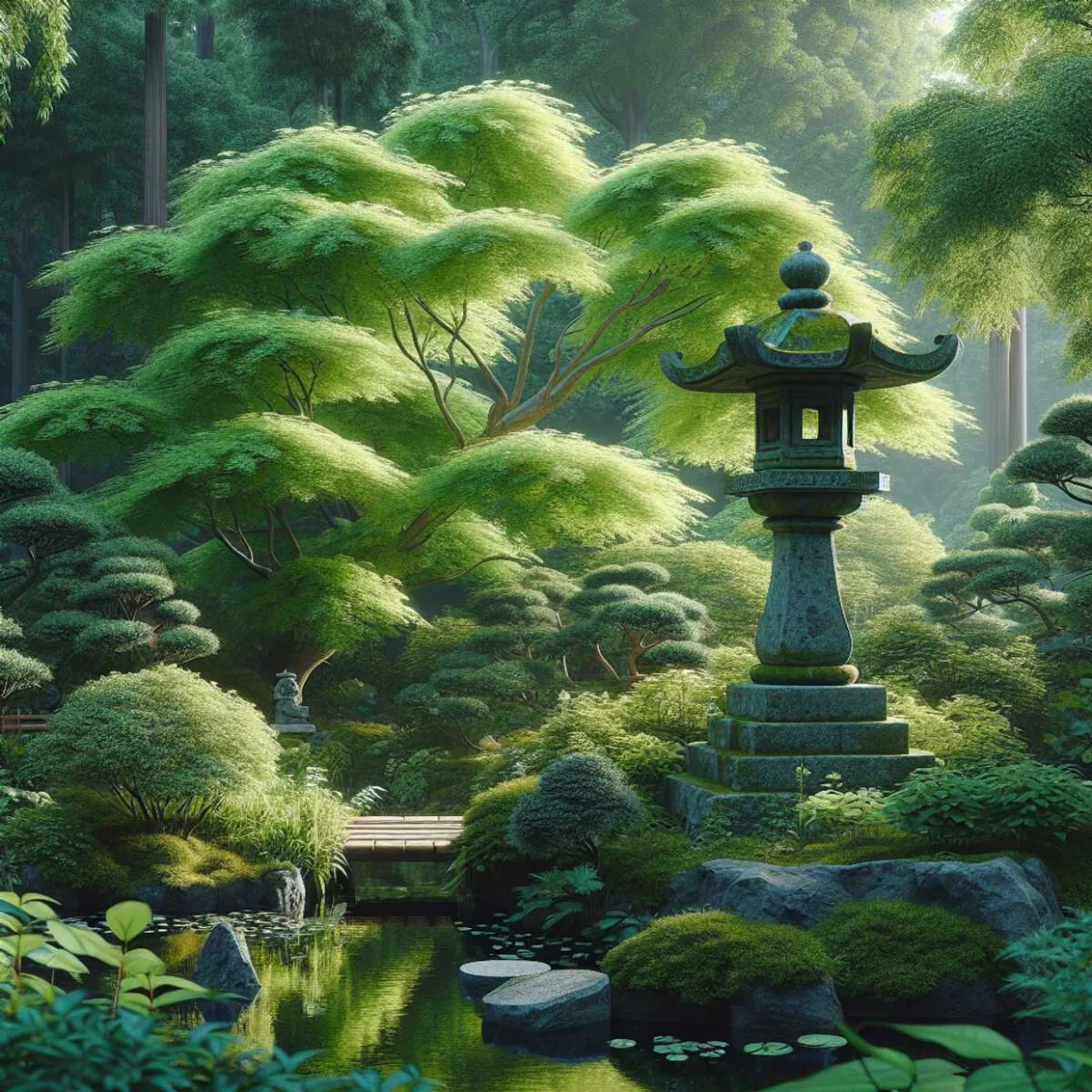
Outdoor decor, when chosen with a keen eye and a mindful approach, can set the tone for your entire outdoor space. It’s the cherry on top of your Japandi style garden, tying together all the elements and contributing significantly to the overall serenity.
Complementing Japandi Style with Outdoor Decor
In Japandi style, less is more. Every piece of decor should serve a purpose and harmonize with its surroundings. A simple stone lantern or a minimalist bench can provide both functionality and aesthetics. When selecting pieces, consider not only their appearance but also their texture and how they interact with light and shadow.
Consider, for example, bamboo accents or stone sculptures that echo Zen-inspired designs. Bamboo wind chimes create soothing sounds in the breeze, adding an auditory element to your peaceful retreat. Stone sculptures, on the other hand, can represent different natural elements depending on their shape and positioning, fostering a deeper connection with nature.
Lunar gardening might seem unrelated at first glance but it’s about observing nature’s rhythms. Incorporating such thoughtful details into your decor choices will enhance the meditative atmosphere that is so central to Japandi gardens.
Choosing Sustainable Materials for Outdoor Furniture
The Japandi style emphasizes sustainability and respect for nature, which naturally extends to your choice of furniture. Opt for pieces made from natural materials such as rattan or cane. These materials are not only sustainable but also durable and weather-resistant, making them an excellent choice for outdoor settings.
Reclaimed wood is another fantastic option. With its rich history and unique imperfections, each piece tells a story while adding warmth and character to your garden. Plus, you’ll be doing your part in reducing waste and promoting sustainability.
A well-placed wooden bench or a set of rattan chairs can create inviting spots for outdoor relaxation, further enhancing the serene atmosphere. With the right choices in outdoor decor, your Japandi garden becomes not just a visual delight, but a sensory experience that promotes tranquility and mindfulness.
As you repair and prepare your garden for the changing seasons, it’s worth considering these elements to contribute to your space’s harmony. Additionally, repairing a garden in the fall is an essential aspect of maintaining its beauty and health.
It’s all about balance – striking the perfect balance between aesthetics and function, nature and craftsmanship, simplicity and comfort. That’s when you truly capture the essence of Japandi style in your outdoor decor.
5. Showcasing Japandi-Inspired Outdoor Spaces
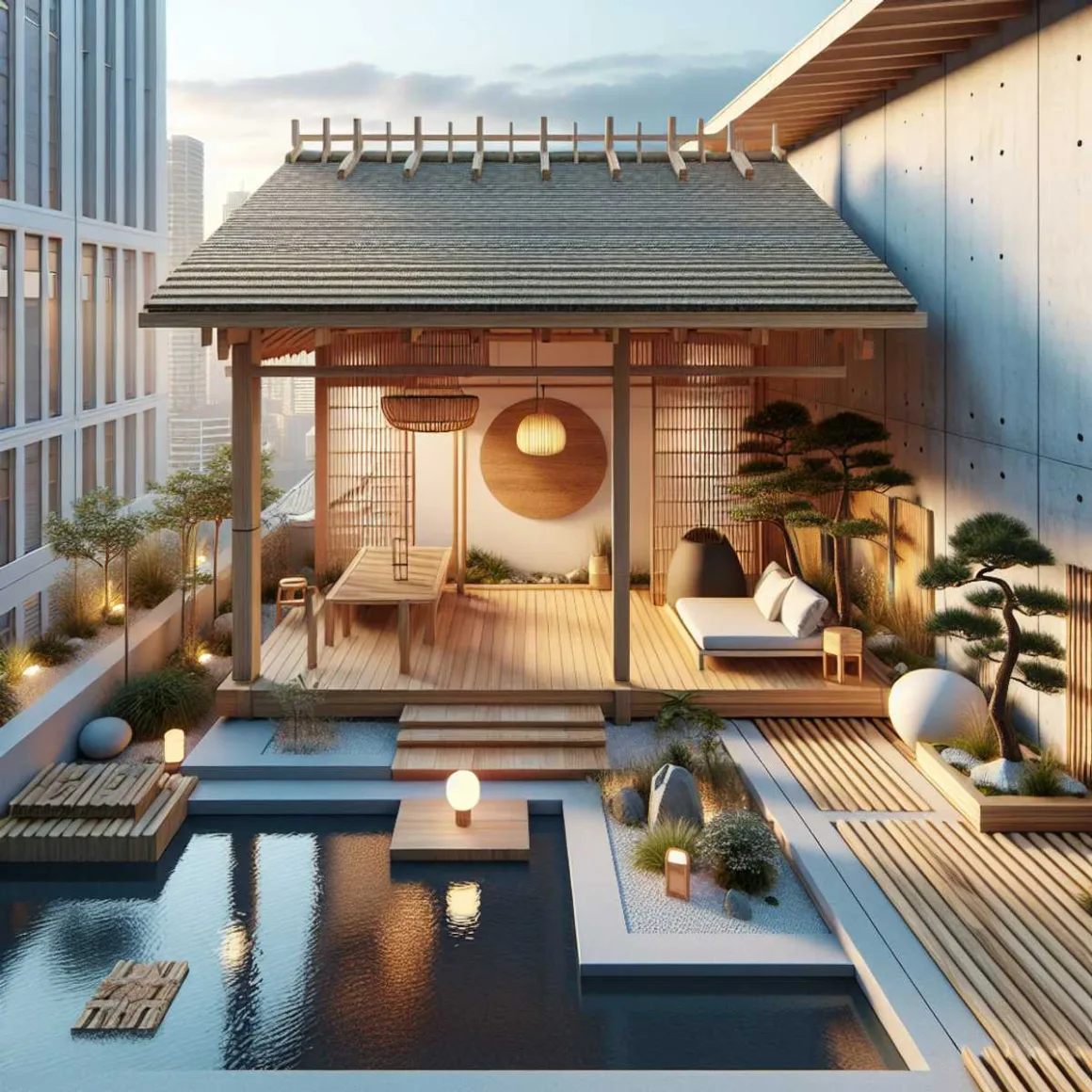
Imagine stepping onto an urban rooftop terrace, where the hustle and bustle of city life fades into the background, replaced by a sense of peace and tranquility. This is the essence of a Japandi terrace—a serene haven in the sky. The fusion of Scandinavian functionality with Japanese minimalism creates outdoor spaces that are not only beautiful but evoke a Zen-like ambiance.
Inspiring Examples of Japandi Outdoor Spaces
The beauty of Japandi design lies in its versatility; it thrives expansively in suburban yards and flourishes with ingenuity on compact urban rooftops. A rooftop garden, with its panoramic views and open sky, provides the perfect canvas for Japandi’s nature-embracing philosophy. Picture low-slung couches paired with sleek, simple planters that house bonsai trees or tranquil grasses swaying gently in the breeze.
Serenity and Tranquility on Your Terrace
To create your own slice of serenity:
- Design with Purpose: Begin with clean lines and a neutral color palette. Each piece should serve a function while contributing to the overall calm.
- Create Layers: Use raised beds or tiered planters to add depth and interest without clutter.
- Focus on Materials: Choose natural, sustainable materials that age gracefully under the open sky—think stone, bamboo, and untreated wood.
Exclusive Accessories for Your Japandi Terrace
Accessorizing your outdoor space is like adding punctuation to a poem—it enhances without overwhelming. Seek out exclusive accessories that embody simplicity and elegance:
- Soft Lighting: Lanterns or subtle LED strips can cast a warm glow during twilight hours.
- Textural Contrast: A mix of materials like smooth pebbles against soft moss adds depth to your garden.
- Functional Decor: Every element should enhance the user experience, from weather-resistant cushions to sleek watering cans that double as art pieces.
For those eager to bring their soil back to life organically, ensuring lush vegetation for their terrace gardens, valuable soil rehabilitation advice may provide insights.
And remember, even when the colder months approach, it’s never too early to plan your springtime Japandi escape. Consider browsing through tips for active winter gardening to keep your green thumb ready.
By integrating these elements thoughtfully, you’ll find yourself enveloped in an outdoor space that’s not just visually stunning but also spiritually uplifting.
6. Maximizing Small Outdoor Spaces with Japandi Design
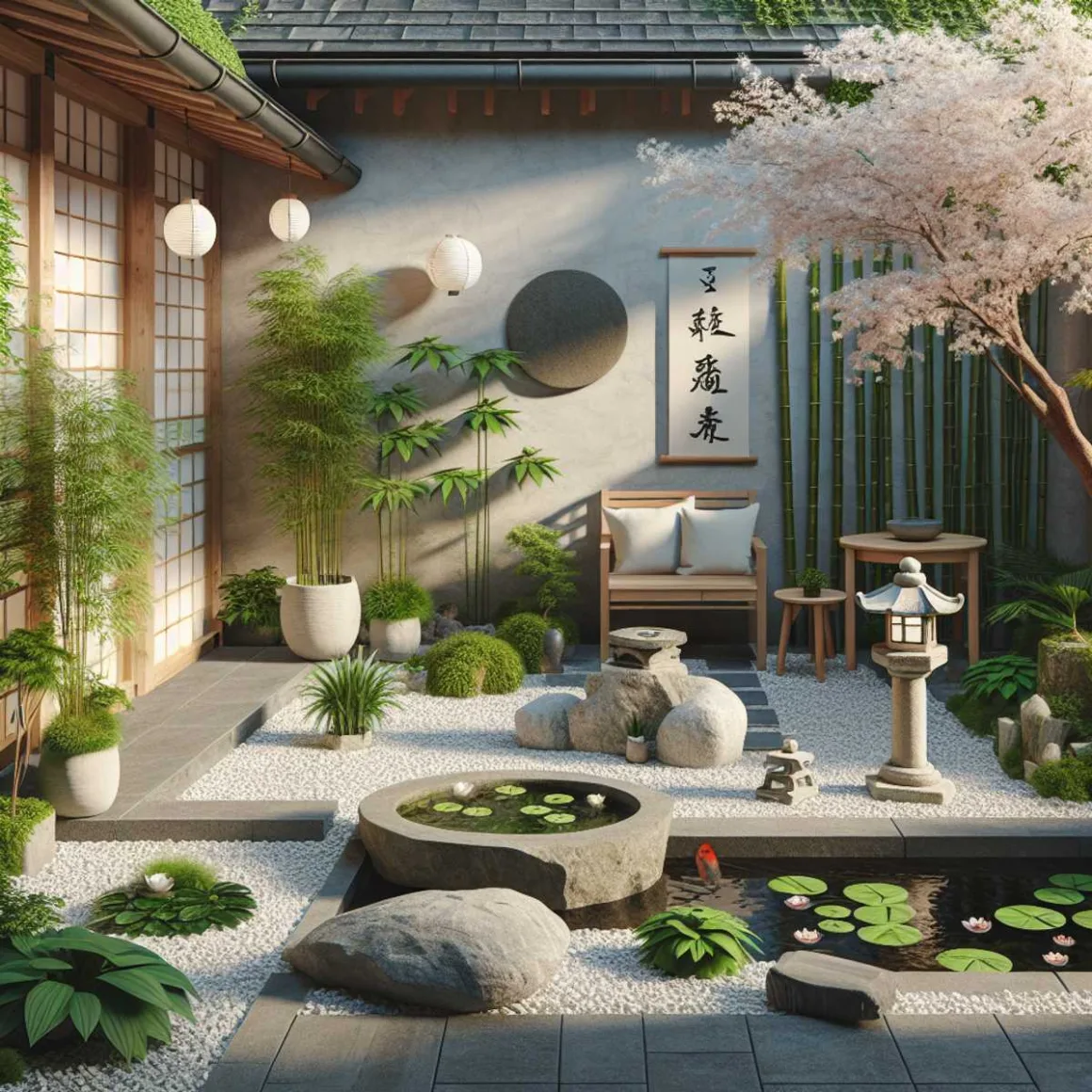
Small outdoor spaces often challenge home lovers to exert their creativity in maximizing space and maintaining an appealing aesthetic. However, no matter how limited your outdoor area is, Japandi design can transform it into a serene oasis. Remember, the minimalist design principle of this style thrives even in the smallest corners!
Embracing Space Limitations
Let’s address the issue of limited space right away. But here’s the thing – it can actually work in your favor! Being forced to simplify your elements allows you to concentrate on what’s essential, enhancing the minimalist vibe that Japandi design is all about.
Here are some tips and tricks for maximizing space:
- Vertical Planting: This technique makes use of upward space, freeing up ground area. Use hanging baskets or wall-mounted planters for a touch of greenery.
- Multi-level Decking: Different levels can help create a sense of depth and provide separate areas for lounging, dining, or gardening.
Incorporating smart storage solutions is also crucial in maintaining a clutter-free environment. Opt for dual-purpose furniture — think benches that open up to reveal storage space or tables with built-in drawers. They serve their function while helping maintain your garden’s clean, minimalist look.
Enhancing Aesthetic Appeal
Remember the importance of aesthetic appeal in creating an inviting atmosphere. Choose furniture pieces with sleek lines and neutral colors to complement the Japandi style’s simplicity. Incorporate natural materials like rattan or bamboo for a touch of warmth and comfort.
Creating Tranquility and Harmony
With careful planning, even the smallest outdoor spaces can exude tranquility and harmony. From your choice of plants to your furniture selection, every element should contribute to creating a serene atmosphere where you can relax and reconnect with nature.
Do you have an urban balcony? No problem! Just as outdoor dining areas offer a private haven to enjoy summer rays, your balcony can be a peaceful retreat amidst the city buzz. And just like the many shades of green in a garden design, your small Japandi space can bloom with tranquility and charm.
Conclusion
Japandi gardens are truly special, offering a perfect mix of calmness, simplicity, and balance. They bring together the best of Japanese minimalism and Scandinavian coziness to create a peaceful atmosphere in your outdoor areas. The great thing about this style is that it works well whether you have a large garden or a small balcony – it’s adaptable and versatile.
By incorporating Japandi elements into your garden, you can greatly enhance your connection with nature and have a place of relaxation. Every stone path, water feature, simple plant arrangement, and Zen-inspired decoration adds to the overall serenity. Even if you only have a tiny outdoor space, you can still turn it into a peaceful oasis by carefully choosing each element.
It’s important to remember that Japandi gardening goes beyond just following a trend – it’s about embracing a lifestyle that values peace, harmony, and sustainability in our outdoor living spaces. For instance, incorporating sustainable plants like hostas into your landscape applications can further enhance these principles.
In the midst of our busy lives, having an outdoor sanctuary that allows us to connect with nature can be incredibly therapeutic. By applying Japandi design principles to your garden, you can create a tranquil haven – your very own Zen retreat.
As we explore more home improvement ideas and trends in future articles, we’ll continue to look at innovative designs and sustainable practices that enhance our living spaces. If you’re interested in adding color to your garden throughout the year, consider checking out our blog post about designing landscapes for winter color.
So why wait? Start embracing the serenity of Japandi gardens today and let it inspire tranquility in every aspect of your life!
FAQs (Frequently Asked Questions)
The key takeaway of this article is to explore how to design your own Japandi-style garden to create a peaceful and harmonious outdoor retreat, regardless of whether you have a spacious yard or a small balcony.
The key characteristics of Japandi style in outdoor areas include incorporating minimalist design principles inspired by Japanese minimalism and Scandinavian comfort, as well as selecting natural materials to create a harmonious blend of aesthetics and sustainability.
Well-planned landscaping is important for a peaceful Japandi garden because it helps create a tranquil atmosphere by using natural materials like stone, gravel, and wood in garden pathways and hardscaping elements, as well as incorporating Zen elements such as rock gardens and water features.
Plants play a crucial role in a Japandi garden, with an emphasis on simplicity and balance. Suitable plant options include cherry blossoms, black pines, bonsai/kokedama, and evergreens, and it’s important to maintain simplicity in the garden while highlighting these key plant options.
A thoughtful selection of outdoor decor can elevate the Japandi aesthetic and contribute to a serene atmosphere by choosing decor that complements the style, incorporating zen-inspired decor elements like bamboo accents and stone sculptures, and opting for minimalist and sustainable materials in furniture selection.
Tips for maximizing space in small outdoor areas while maintaining the essence of Japandi design include incorporating smart storage solutions and multipurpose furniture for functionality and aesthetics, as well as creating an inviting and serene atmosphere despite limited space.










